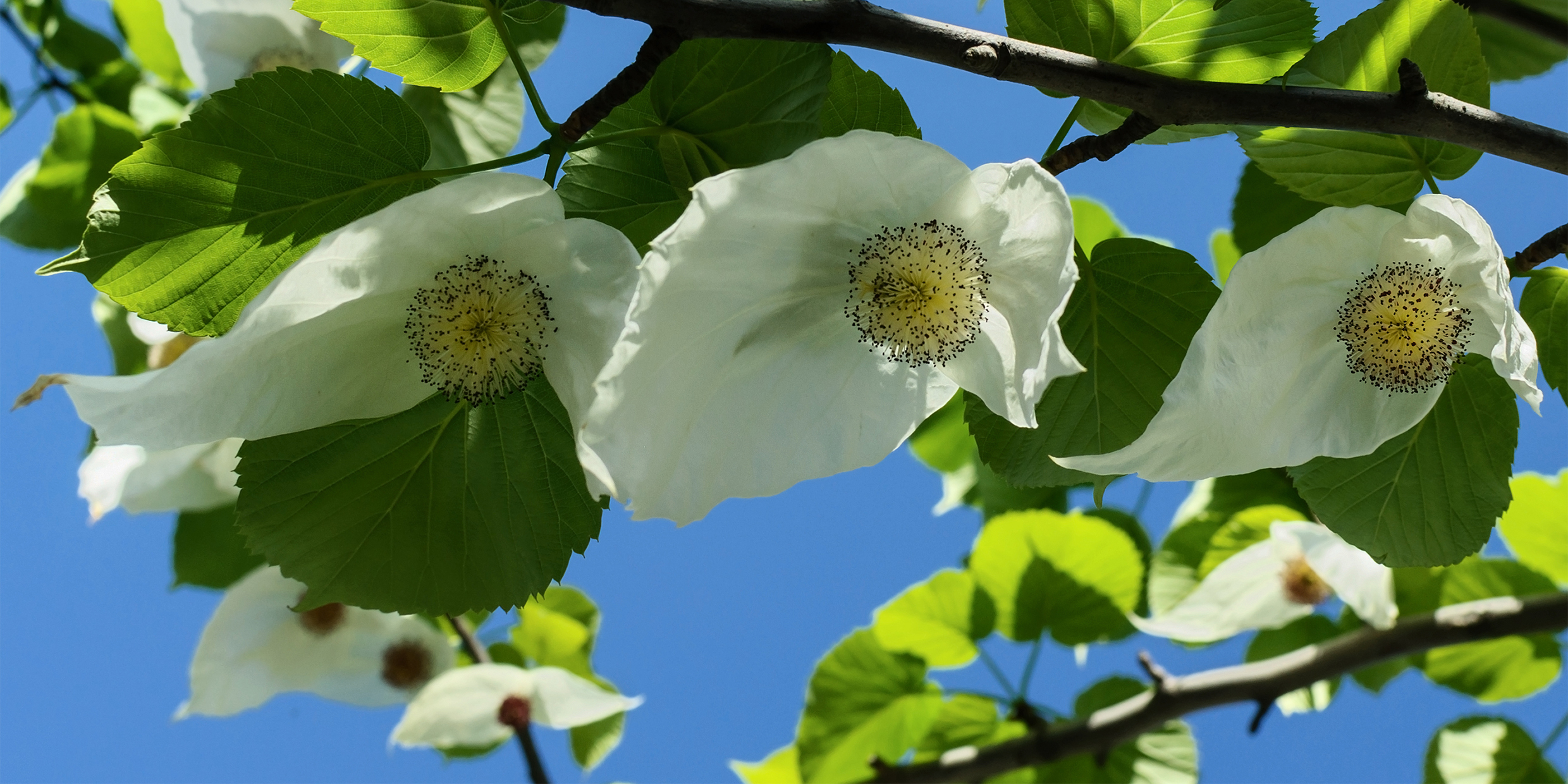Originally published 5 May 1985
On the southern slope of Bussey Hill in Boston’s Arnold Arboretum there are two trees of the species Davidia involucrata. For most of the year the trees are inconspicuous. But in mid-May, at about the time the lilacs bloom, Davidia flowers. Each flower cluster has two leafy bracts that become snowy white as the flowers mature. One bract is about the size of a man’s hand, the other, half that size. When Davidia is in bloom is looks as if a thousand white doves are fluttering in the branches of the tree.
It is called the dove tree.
Native of China
The dove tree is a native of the rugged mountain country of western China. The tree came to the attention of Western horticulturists when it was described by the French missionary priest Père David in 1869. Thirty years later, specimens from the tree were provided to the Veitch Nurseries of England by Dr. Augustine Henry, of Simao, Yunnan, China. Henry’s materials confirmed David’s description of an exceptional tree. The Veitch firm sought a collector to go to China, to discover from Henry the location of the tree, and to return fruits to England for cultivation. The man selected for this task was Ernest Henry Wilson.
On April 11, 1899, Wilson sailed from Liverpool en route to China via the United States. He broke his journey for five days in Boston, where he consulted with the staff of the Arnold Arboretum on the collection of herbarium specimens and on the packing of seeds and plants for shipment. He then crossed the country by train and sailed from San Francisco, reaching China on the 3rd of June.
Wilson’s first task was to find Henry, in a remote part of southern China near the borders of Laos and Burma. He approached through the port of Haiphong and the city of Hanoi in French Indo-China, where he was advised to turn back. China was in turmoil (this was the year before the Boxer Rebellion), and atrocities against foreigners were common. Wilson persisted, and made his way into the interior by river steamer, native boat, mule-back, and sedan chair. There were rumors of mayhem and massacre, and everywhere he saw the grisly aftermath of riot and punishment. The heat of the season was almost unendurable, disease was rampant, and the rivers were in flood. After many trials and a rigorous journey, Wilson met Henry in Simao. Henry sketched for him a map of western China, and marked the spot where he had found growing the only Davidia he had ever seen in all of his travels in China. With this precious treasure map, Wilson returned to the coast.
In April 1900, Wilson ascended the Yangtze by boat in search of Henry’s sole Davidia. Again he was advised to turn back. The country was troubled by rioting between Christians and anti-Christian villagers. Hundreds of people had been killed and entire villages burned to the ground. Western missionaries had been barbarously murdered. Wilson pressed on, at last arriving in the village where Henry had found Davidia 12 years earlier. The tree had been cut down to build a house! Nothing remained but a stump.
Now Wilson resolved to travel another thousand miles into the interior, and to search for Davidia in the remote region were Père David had found it in 1869. But on May 19, 1900, while collecting near the hamlet of Ta-wan, he unexpectedly came upon a Davidia in full flower. The tree was 50 feet tall, and (as Wilson wrote) “more beautiful than words can portray.” That chance discovery was the crowning experience of his life.
Wilson later found other trees of the Davidia, and shipped many seeds back to England. One of the two dove trees now growing in the Arnold Arboretum derives from one of those seeds.
To Wilson’s chagrin, his dove tree was not the first to be introduced in the West. In 1897, a French missionary shipped seeds of the tree to the arboretum of Maurice de Vilmorin at Nogent-sur-Vernisson, France. From those seeds a single plant was raised. A rooted layer from the plant was sent to the Arnold Arboretum in Boston, where it is still growing, the other of the two doves trees on Bussey Hill.
1000 plants collected
Ernest Wilson made one more trip to China for the Veitch firm, and then two more for the Arnold Arboretum. More than a thousand different plants were collected by him and introduced into England and America. Everywhere on the grounds of the Arnold Arboretum his work remains in evidence. Following his adventures as a collector, Wilson became the assistant director of the Arnold Arboretum and made many contributions to the science of botany. After the death of Charles Sprague Sargent, the founder of the arboretum, Wilson was given the title of Keeper of the Arnold Arboretum. He continued Sargent’s dream of making that place a great museum of nature and center of horticultural research.
At lilac time, make your way to the Arnold Arboretum in Jamaica Plain. Stop at the Visitor’s Center to collect a map, and then head for the back side of Bussey Hill. There, you will find the trees with a thousand fluttering doves. Your adventure in search of Davidia will be less demanding than Wilson’s but your reward will be as great. And you will see for yourself why the Veitch nurseries sent their agent half way around the world to collect the fruits of this beautiful plant.
Four examples of Davidia involucrata are now part of the collection at the Arnold Arboretum in Jamaica Plain, Massachusetts. ‑Ed.



